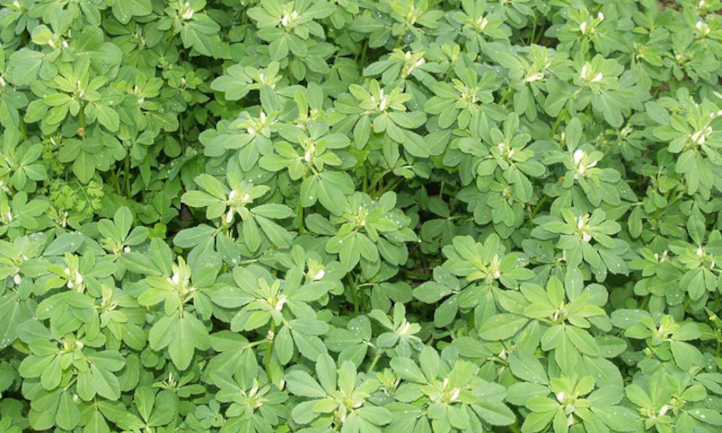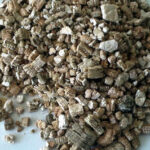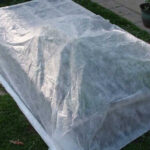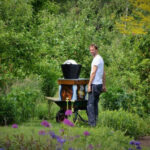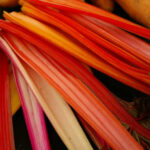I’d hazard a guess that the fenugreek plant is not a popular plant to grow in the vegetable garden. Still, this is surprising given the multiple uses fenugreek provides to the home gardener! Civilizations across the globe have been growing this lovely legume for millenniums. Fenugreek seeds were discovered in Tutankhamun’s tomb, but the oldest archaeological finds are from carbon-dated seeds found in Iraq, believed to be 6000 yrs old. It makes you wonder why growing fenugreek is not popular today.
Fenugreek is a genuine all-rounder, grown for its leaves and seeds. It provides good bulk animal fodder, has many potential medicinal benefits, makes an excellent cover or intercropping plant with soil building properties, and is extremely easy to grow.
The leaves and seeds are associated mainly with southeast Asian, Middle Eastern, and Indian cuisine, curry powders, and spice mixes, but the unique sweet, nutty almost maple syrup-like flavor and aroma of fenugreek lends itself to a much wider menu. Fresh leaves can be used like spinach and stirred into pasta and sauces or added to salads and the ground spice is delicious sprinkled on roasted squash and potatoes. Sprouted fenugreek seeds and microgreens are also becoming a firm favorite packing a spicy, sweet nutty punch.
Quick Care Guide

| Common Name(s) | Fenugreek, methi, Greek hay, Greek fennel |
| Scientific Name | Trigonella foenum-graecum |
| Days to Harvest | 20-30 days leaves; 3-5 months for seed |
| Light | Full sun to partial shade |
| Water | Regular watering |
| Soil | Well-drained, moisture-retentive |
| Fertilizer | None required |
| Pests | Aphids |
| Diseases | Charcoal rot, powdery mildew |
All About The Fenugreek Plant
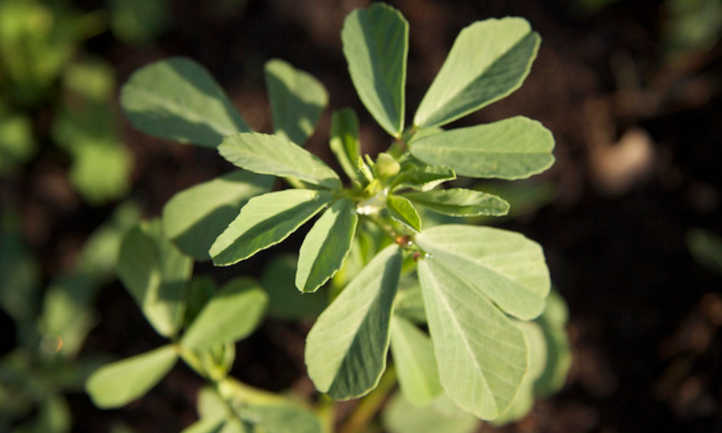
The botanical name for fenugreek is quite a mouthful, Trigonella foenum-graecum. Fenugreek is part of the legume or pea family, Fabaceae. There are many common names for fenugreek including interesting ones like “Greek hay”, but the most well-known names are ‘fenugreek’ in English, and ‘methi’ in Hindi, Urdu, and Punjabi. Fenugreek originates in the warm climates of the Middle East, India, and northern Africa, but is adaptable to colder locations if timed correctly. Known as a cool weather plant in its countries of origin, fenugreek is grown in the cooler months of autumn to spring. In cooler climates, it can be started in spring and grown throughout the warmer summer months.
Mature plants grown for seed can reach 1-2 ft tall (30–60cms). Plants grown for fresh fenugreek leaves and harvested as a cut and come again leaf crop will grow to around 12ins (30cms). The leaves and stems are green and soft. Fenugreek leaves have three oval leaflets like clover. Flowers are white or yellow and develop from the leaf axil once the plant is close to maturity. The flowers are similar in appearance to other legumes like peas and beans and have a strong maple syrup fragrance, especially on warm sunny days. Curved yellow seed pods are produced after flowering containing small yellow-brown seeds.
Fenugreek plants have vigorous growth. Seeds germinate quickly and fresh leaves are ready to harvest in as little as 20-30 days. Seeds take a little longer to ripen, 3-5 months. Both the seeds and leaves of fenugreek are edible but used in different ways. Fresh fenugreek leaves tend to be mixed into dishes or dried and used to prepare delicious recipes. Fenugreek seeds are usually dried, and the powdered seeds can be used as a spice powder or whole. Fenugreek seed can also be dry roasted and used as a whole seed to add a bit of crunch.
There are multiple ways to use and grow fenugreek in your garden. Like legumes, their roots fix nitrogen into soils making it an excellent cover crop for beds left bare for a few months. Intercropping with fenugreek makes nitrogen available to other crops as well as smothering competing weeds. Tomato and corn are perfect intercropping companions. Fenugreek can also be sown densely as a field crop and used as animal feed.
Fenugreek plants have long been used medicinally. It is believed to reduce fevers and treat coughs, sore throats, bronchitis, and constipation. The fenugreek is also occasionally used to treat minor skin irritations and to balance hormones. Of course, it’s always advisable to consult your doctor before using herbal medicine to make certain you don’t have any counteractions.
Planting Fenugreek
In warm climate zones, fenugreek seeds can be sown all year round. In cooler northern climates, plant fenugreek seeds indoors in containers in early spring or sow directly outdoors after all risk of frost has passed in the mid to late spring. Fenugreek has shallow fibrous roots and does not establish well if transplanted, so it’s best to sow where they will grow until harvest. Sow earlier in the season if growing for seed production as fenugreek needs up to 5 months for seed pods to develop and ripen.
Growing fenugreek in containers is perfect especially if growing for leaves. Seeds can be sown densely, (1-2 inches apart) and the leaves are harvested as a cut-and-come-again crop, producing around three harvests per plant. Also, being a shallow-rooted plant, fenugreek can be grown in a shallow, wide planter or even a window box. A pot indoors in a well-lit location is also an option and can be an attractive addition. These sprout quickly, too!
Choose an open sunny spot with well-drained, moisture-retentive soil. Warmer climates should aim to provide some afternoon shade from early summer to late summer to prevent plants from wilting. To sow simply sprinkle seeds in a container filled with fresh compost or sow in drills ¼ inch deep and cover with compost. If growing for seed, thin seedlings to 5ins (15cm). Spacing can be less if sowing for leaves only.
Care
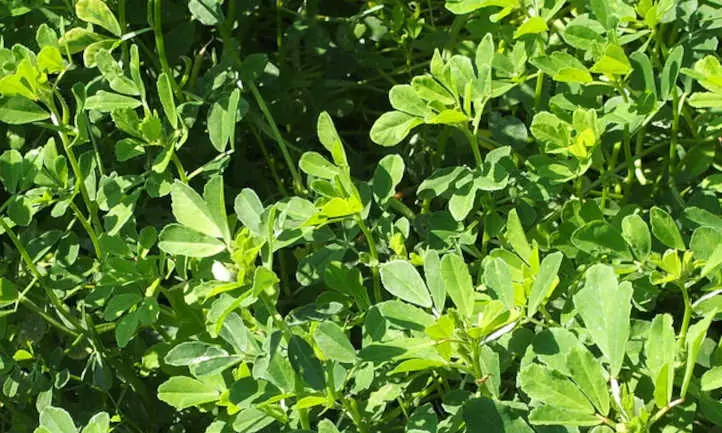
Growing fenugreek at home is easy! Here are some tips on getting the most from your fenugreek crop.
Sun and Temperature
Fenugreek requires around 5-6 hours of direct sun per day. In warm climates, your crop will benefit from some partial shade at mid-day, and in fact will tolerate afternoon shade once you start getting to medium heat or above, which is common in the height of summer. In cooler climates, plant in full sun. The temperature range for growing fenugreek is 50-90ºF (10-32ºC). It can be grown all year round in USDA zone 9 to 12, but unfortunately, fenugreek does not tolerate cold well, so is an annual in cold climates.
Water and Humidity
Watering schedules will depend on your climate so it’s best to regularly check ground moisture levels and water accordingly. As a general rule, if the top 1-2 inches of soil are dry give your plants a good long drink. The roots of fenugreek are quite shallow and can dehydrate quickly resulting in wilt. Water in the morning with water directed at the soil and avoid getting the leaves wet. Timed soaker hoses will give you the most consistent results.
If you’re in a dry location, you may need to water more frequently, particularly during the hotter summer months. This is especially true if you’re growing your herb garden in containers; containers often dry out much more rapidly and your herb garden can suffer if you’re not paying close attention. Mulching the ground around your herbs can help you to ensure your garden stays hydrated, too.
Soil
Grow fenugreek in moisture-retentive, well-drained soil. The fertility of your growing medium is not really an issue but like most crops, fenugreek benefits from soils amended with compost or well-rotted manure at the start of the season, especially if growing for seed. Fenugreek tolerates poor soils and will in fact improve any soil in which it grows by fixing nitrogen. Grow fenugreek in slightly alkaline soil if possible. Soil pH should be within the range of 6.5 to 8.2.
Fertilizing
Soil prepared with compost or manure is adequate to grow fenugreek. No additional fertilizer is necessary. As a nitrogen-fixing plant, excess nitrogen may stunt fenugreek growth.
Pruning
Treat your plants as cut and come again if growing for leaves, harvesting up to three times from one plant. Pruning encourages bushy growth supplying you with even more leaves as plants mature. If growing fenugreek for seeds, try not to harvest too many leaves but do pinch out the top third of the mature plant to encourage branching.
Propagation
Fenugreek seeds should be sown directly into their final growing positions either in the ground or in containers, rather than transplanted. The plant’s shallow root system does not transplant well. Alternatively, sow seeds into peat/coir biodegradable pots indoors and plant out when all risk of frost has passed and average daily temperatures are above 50ºF (10ºC).
Sow seeds ¼ inch deep and cover. Fenugreek can be sown densely 1-2 inches (2.5-5cms) apart if growing for leaves and 5 inches (15cms) apart if growing for seeds. Soak seeds for about 8 hours before sowing to help speed up germination, which typically takes between 7 and 10 days. Keep the soil consistently moist until seedlings emerge and plants establish.
Harvesting and Storing
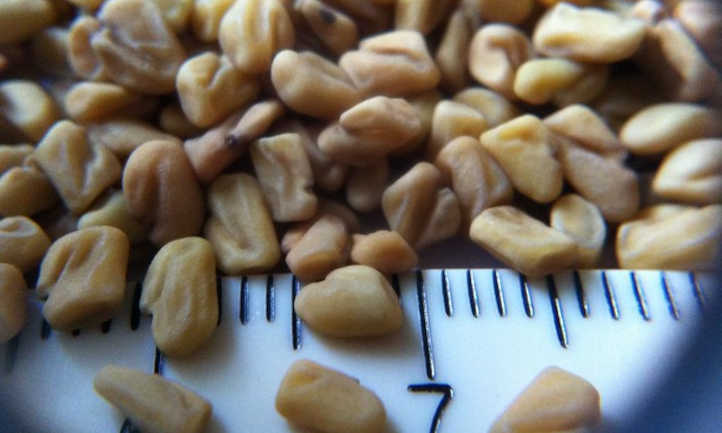
Harvesting fenugreek couldn’t be easier, and it can also be stored for cooking and sowing future crops.
Harvesting
Fenugreek leaves are ready to harvest in as little as 20-30 days. Leaves may become tough and bitter once flowers are formed so aim to harvest before this for optimum flavor. Cut stems a few inches above the base of plants once they reach 10 inches (25cms) tall. Lots of lush new growth will follow in just a few weeks. Leaves can be harvested around three times per plant before plants bolt.
Seed pods are ready to harvest in 3-5 months when the curled pods turn yellow and become crispy. Don’t let them get too crispy, or else the pods open and seeds will be lost while harvesting. Ripened pods can be peeled or rolled between hands to release 10-20 seeds per pod.
Storing
Fresh leaves can be stored in the refrigerator rolled up in damp kitchen paper for up to a week. Leaves can also be dried in a similar way to herbs: tied in bunches and dried upside down, or laid flat on a mesh tray in a dark, cool well-ventilated room. Once completely dry, crumble the leaves and store them in an airtight container for up to a year.
Dry seeds on a flat mesh tray the same way you would dry leaves. A dehydrator can also be used. Once dried, they can be stored in an airtight container for up to 3 years.
Troubleshooting
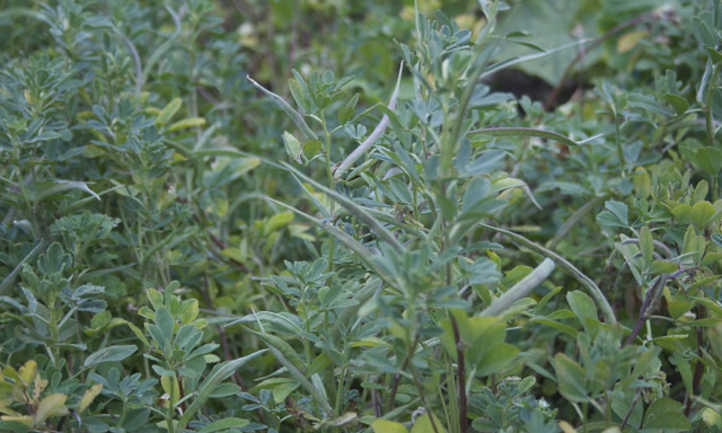
Although easy to grow, there are a few pests and diseases that affect fenugreek, but nothing that isn’t easily resolved.
Pests
Fenugreek leaves are at risk of aphid (Aphidoidea) attack. Aphids are small insects that feed on the sap of new growth. Companion planting with marigolds or calendula may help deter aphids and encourage beneficial insects into the garden to feed on them. Alternatively, spray with an organic insecticidal soap or neem oil. Squishing aphids with fingers or a quick blast of water can also help to reduce numbers.
Diseases
Charcoal rot is a soil-borne root and stem disease that causes black/brown/greyish discoloration and cankers on all parts of a fenugreek plant, ultimately causing wilt, leaf drop, and death. Once the rot takes hold, it’s difficult to treat. Affected plants should be destroyed and legume family plants not grown in that location for 2-3 rotation cycles. The rot thrives in hot, dry growing conditions causing heat stress. Providing shade during the hottest part of the day will reduce the risk alongside adequate spacing, good ventilation, and water regularly.
Fenugreek leaves are susceptible to powdery mildew if grown too densely in humid conditions or overshadowed. It grows as thick dust on leaves, inhibiting photosynthesis and hindering growth. To avoid, maintain good garden hygiene, remove infected foliage, and rotate crops every year. Provide adequate sunlight, good air circulation, and treat affected plants with an organic fungicide such as sulfur or potassium bicarbonate.
Fenugreek likes to grow in consistently moist soil but never wet. Waterlogged soil may result in the fine fibrous roots rotting due to fungal development in anaerobic, soggy conditions. Signs of root rot are stunted growth, wilting and yellowing leaves. Planting in soils with good drainage and a well-managed watering regime should help prevent root rot.
Frequently Asked Questions
Q: What is fenugreek plant used for?
A: Fenugreek is traditionally used in Indian and Southeast Asian cooking but can be used in lots of other sauces, casseroles, soups, and meat and vegetable dishes. Leaves can be used fresh or dried and seeds can be used whole or ground in mixed spices and dry rubs. Seed sprouts can be sprinkled on salads to add a sweet nutty crunch.
Q: Are fenugreek flowers edible?
A: Leaves and seeds tend to be the main edible parts of fenugreek.

